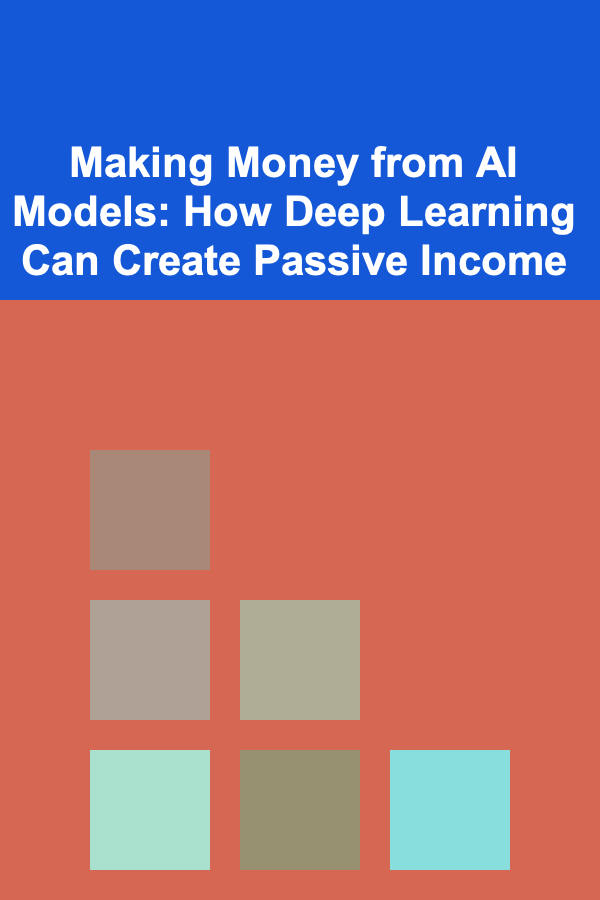
Making Money from AI Models: How Deep Learning Can Create Passive Income
ebook include PDF & Audio bundle (Micro Guide)
$12.99$6.99
Limited Time Offer! Order within the next:

The rapid advancements in artificial intelligence (AI), particularly in the realm of deep learning, have revolutionized industries worldwide. With applications ranging from healthcare to finance, autonomous driving, and entertainment, deep learning models are becoming increasingly integral to the modern technological landscape. While deep learning models can solve complex problems and generate incredible value for businesses, they also provide a unique opportunity for individuals and companies to create passive income.
In this article, we'll explore how deep learning and AI models can be used as a source of passive income. From selling pre-trained models to creating AI-driven products, there are various ways to monetize your AI skills and leverage deep learning to generate recurring revenue. Whether you are an AI expert or a beginner with an interest in machine learning, this article will outline strategies that can help you turn your AI models into income-generating assets.
The Potential of AI Models in Generating Passive Income
Before diving into monetization strategies, it's important to first understand why AI models have the potential to create passive income. AI and deep learning models are built to perform tasks that traditionally required human intervention---tasks like image recognition, natural language processing (NLP), time series forecasting, and much more. These models, once trained and fine-tuned, can often operate independently, making them ideal candidates for generating income with minimal ongoing effort.
Unlike traditional products or services that require constant maintenance or active engagement, AI models---especially pre-trained models---can be used over and over again with little additional effort. This means that after the initial development and training phase, AI models can continue to provide value without the need for constant updates, making them perfect for generating passive income streams.
Key Characteristics of AI Models That Enable Passive Income:
- Scalability: Once an AI model is developed, it can be deployed to work with hundreds or thousands of customers without requiring significant additional work.
- Automation: AI models are often capable of automating repetitive tasks, reducing the need for manual intervention.
- Customizability: Many AI models can be customized to fit different use cases, allowing creators to sell or license them to various industries.
- Recurring Revenue: AI models can be monetized through subscription models, licensing fees, or even paid APIs, creating a consistent income stream.
By understanding these characteristics, AI practitioners can capitalize on the power of deep learning models to create new avenues for income.
Building a Strong Foundation: Skills Needed to Create AI Models
Creating AI models capable of generating passive income requires a combination of deep learning expertise, technical skills, and business acumen. Here are some essential skills needed to start creating monetizable AI models:
2.1. Deep Learning Fundamentals
Before you can build models that are capable of generating income, it's crucial to have a strong foundation in deep learning. Some of the core areas to focus on include:
- Neural Networks: Understanding how deep learning models work at a basic level, including backpropagation and gradient descent, is essential. Neural networks form the basis for more complex models.
- Convolutional Neural Networks (CNNs): These models are especially useful for image classification and object detection tasks, making them highly valuable in fields like computer vision.
- Recurrent Neural Networks (RNNs): These are designed for sequential data and are commonly used for time-series analysis, natural language processing, and speech recognition.
- Generative Models: Models such as Generative Adversarial Networks (GANs) and Variational Autoencoders (VAEs) are used to generate synthetic data, which can have applications in areas such as art, music, and data augmentation.
- Transformers and Attention Mechanisms: Transformers have revolutionized NLP tasks, with models like BERT and GPT taking over everything from translation to text generation.
2.2. Programming and Technical Tools
Having a strong grasp of programming languages like Python and R is vital when building deep learning models. Additionally, proficiency with deep learning frameworks such as TensorFlow, PyTorch, and Keras is essential. You'll also need to be comfortable working with other technical tools like:
- NumPy and Pandas: These libraries are essential for data manipulation and analysis.
- Matplotlib and Seaborn: Useful for data visualization.
- Cloud Platforms: Tools like Google Cloud, AWS, and Microsoft Azure allow you to deploy and scale your models easily.
2.3. Data Handling and Preprocessing
Data is the foundation of all AI models. Developing an understanding of data preprocessing techniques, such as normalization, data augmentation, and feature engineering, is crucial for ensuring that your models perform well. It's also important to be familiar with tools for collecting and cleaning data, which can be time-consuming but necessary for creating high-quality AI models.
2.4. Model Deployment and Maintenance
Once your AI model is trained, it's important to understand how to deploy it in a production environment. This can involve setting up APIs, managing cloud resources, and ensuring that the model continues to operate smoothly over time. This knowledge is critical for ensuring that your AI models can function in a way that generates ongoing revenue.
Strategies for Monetizing AI Models
Now that we've established the skills required to create AI models, let's look at various strategies for monetizing those models and turning them into passive income streams.
3.1. Selling Pre-Trained AI Models
One of the most straightforward ways to monetize your AI models is by selling pre-trained models. These are models that you've already trained on specific tasks and that can be licensed or sold to others who need similar functionality but lack the resources or expertise to train the models themselves.
AI Model Marketplaces
There are several platforms where you can sell pre-trained models, such as:
- Hugging Face: A popular platform for sharing pre-trained NLP models, including BERT, GPT, and other transformer-based models.
- TensorFlow Hub: A platform by Google where users can share and download pre-trained models for various applications.
- Modelplace.AI: A marketplace specifically for AI and deep learning models, where you can upload your pre-trained models and offer them to businesses and developers.
By selling your models on these platforms, you can earn money through one-time sales or licensing agreements, allowing others to incorporate your models into their applications.
Licensing Your Models
In addition to selling pre-trained models outright, you can license them to clients for a recurring fee. This means clients would pay for access to your model on an ongoing basis. Licensing agreements can include terms such as the number of API calls per month, access to updates, or exclusive rights to certain industries or applications. This model can create a steady revenue stream over time.
3.2. Offering AI-as-a-Service (AIaaS)
Instead of selling your models outright, another way to monetize them is by offering them as a service. AI-as-a-Service (AIaaS) involves providing businesses with access to your AI models through an API or cloud service.
For example, you might create a model that performs image recognition and offer it as a service through a web API. Businesses that need image recognition capabilities can access your service for a fee, paying based on usage or on a subscription basis. This model provides a recurring income stream as clients use your API to integrate AI functionality into their applications.
Popular Platforms for Offering AIaaS
- AWS Marketplace: Offers tools for monetizing AI and machine learning services by creating custom APIs or applications that clients can integrate into their own infrastructure.
- Google Cloud AI and Azure AI: Both offer platforms for monetizing AI models through subscription-based access or pay-per-use models.
3.3. Building and Selling AI Products
If you're inclined towards entrepreneurship, you can use your deep learning skills to build AI-powered products that can generate passive income. These products can be SaaS platforms, software applications, or even physical products that leverage AI.
Examples of AI Products
- AI Chatbots: You could develop a chatbot that businesses can integrate into their websites to automate customer service.
- Automated Content Generation: Build a tool that uses deep learning models to generate content, such as blog posts or social media updates, on demand.
- Predictive Analytics Tools: Create a platform that leverages AI to help businesses predict sales trends, customer behavior, or even stock market movements.
Once these products are developed, you can monetize them through subscriptions or one-time purchases. By continuously improving the product and offering customer support, you can create a sustainable source of passive income.
3.4. Teaching and Content Creation
AI and deep learning are in high demand, and many individuals and businesses are willing to pay for quality education on these topics. By sharing your knowledge and experience, you can monetize your expertise through online courses, coaching, or content creation.
Creating Online Courses
Platforms like Udemy , Coursera , and Teachable allow you to create and sell online courses. You can develop courses that teach deep learning from the ground up, explain advanced techniques, or provide specialized training in areas like computer vision or NLP. Once created, these courses can generate passive income as long as they continue to attract new students.
YouTube and Blogging
If you enjoy content creation, consider starting a YouTube channel or blog focused on AI, deep learning, and related topics. By generating valuable content, you can attract an audience and monetize it through ads, sponsorships, affiliate marketing, or even selling your own courses and consulting services.
3.5. Open-Source Projects and Donations
If you're passionate about contributing to the AI community, creating open-source AI models can be another avenue for generating passive income. Open-source projects, once they gain traction, can attract donations, sponsorships, and even paid opportunities from companies that wish to use or support your work.
Crowdfunding and Sponsorships
Platforms like GitHub Sponsors , Patreon , and OpenCollective allow you to receive donations and financial support for open-source projects. Additionally, businesses may sponsor your work in exchange for visibility or the development of features that are useful to them.
3.6. Data Labeling and Model Training Services
Many businesses require custom AI models but don't have the necessary expertise to train them. As a deep learning expert, you can offer model training services, including data labeling and annotation, to help these businesses develop their own AI solutions. Once these models are trained, you could also offer them as services or even sell them to other companies.
Conclusion
Deep learning presents tremendous opportunities for generating passive income. Whether you're selling pre-trained models, offering AI-as-a-Service, building AI-powered products, or creating educational content, there are numerous ways to monetize your expertise and create lasting revenue streams. By mastering the technical skills needed to build high-quality models, understanding the business side of AI, and continuously innovating, you can leverage deep learning to generate significant passive income and build a successful career or business in the AI space.

How to Choose Between Short-Term vs. Long-Term Rentals
Read More
How to Create a DIY Photo Booth for Your Party
Read More
How to Design Custom Shelving Solutions for Every Room
Read More
How to Stage a Small Home to Maximize Space and Appeal
Read More
How to Store Long-Handled Tools Safely
Read More
Why You Need a Dedicated Space for Hobbies and Crafts
Read MoreOther Products

How to Choose Between Short-Term vs. Long-Term Rentals
Read More
How to Create a DIY Photo Booth for Your Party
Read More
How to Design Custom Shelving Solutions for Every Room
Read More
How to Stage a Small Home to Maximize Space and Appeal
Read More
How to Store Long-Handled Tools Safely
Read More